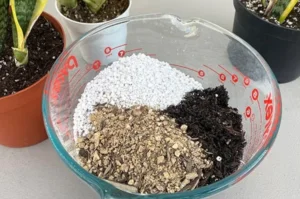Follow this list to make sure your snake plant satisfied:
- Choose a suitable pot with drainage holes.
- Use well-draining cactus compost.
- Place in indirect sunlight.
- Water fortnightly.
- Keep away from extreme temperatures.
- Repot when necessary.
- Use a fresh, wet cloth to occasionally wipe the leaves.
- In spring and summer, feed with liquid fertilizer once a month.
About Snake Plants:
Snake plants, also known as Sansevieria, are resilient houseplants native to Africa. They are known for their striking foliage and air-purifying properties, making them a popular choice for indoor growers. With minimal care requirements, snake plants are perfect for beginners and seasoned plant enthusiasts alike.
| Name | Snake Plant, Mother-in-law’s tongue |
| Botanical Name | Dracaena trifasciata/ Sansevieria trifasciata |
| Family | Asparagaceae |
| Light | Indirect sunlight |
| Soil | Well-draining cactus compost |
| Temperature | Moderate, between 60-80°F |
| Humidity | Low to moderate |
| Maintenance | Low, with occasional repotting and removal of dust from leaves |
| Native Area | West Africa |
| Bloom Time | Spring, Summer |
How to Take Care of a Snake Plant?
Indirect sunlight and mild weather are ideal for snake plants for growth. Watering them every two weeks is preferred, allowing the soil to dry out between waterings. To make sure proper drainage and avoid root rot, use cactus compost that drains well. Regularly wipe down the leaves to remove dust and keep them looking appealing.
How Often Should We Water Our Snake Plant?
Water your snake plant fortnightly, and let the soil dry completely between waterings. This can vary depending on the environment, but it typically occurs every 2-4 weeks.
How Much Light Does a Snake Plant Need?
Snake plants prefer indirect sunlight. Don’t put them in the sun directly because it might hurt their leaves.
What’s the Best Temperature for a Snake Plant?
Moderate temperatures between 60-80°F are ideal for snake plants. Avoid exposing them to extreme temperatures or drafts, which can stress the plant.
Which Soil Type Is Ideal for Snake Plants?
Well-draining cactus compost provides the ideal growing medium for snake plants. It keeps water out while also allowing roots to breathe.
How Do I Make My Snake Plant Healthy?
Make sure your snake plant is placed in an area with good airflow and few drafts. Regularly remove dust from the leaves to promote healthy growth and also overwatering can lead to root rot, so avoid it.
How Much Humidity Do Snake Plants Need?
Snake plants prefer low to moderate humidity levels. They can tolerate dry indoor conditions, making them suitable for various climates.
When Should We Repot Our Snake Plant?
Repot your snake plant when it outgrows its current container or if you notice roots becoming root-bound. Typically, this occurs every 1-2 years.
Recommended Varieties:
- Sansevieria trifasciata (Mother-in-law’s tongue)
- Sansevieria cylindrica (Cylindrical snake plant)
- Sansevieria moonshine
Frequently Asked Questions (FAQs):
Can snake plants survive in low-light environments?
Yes, snake plants can survive low light, although they prefer indirect sunlight for optimal growth.
How do I propagate my snake plant?
Snake plants can be propagated easily through division or leaf cuttings. Simply separate the pups from the parent plant or cut a healthy leaf into sections and plant them in well-draining soil.







1 thought on “How to Care for a Snake Plant”
Thanks for sharing useful tips